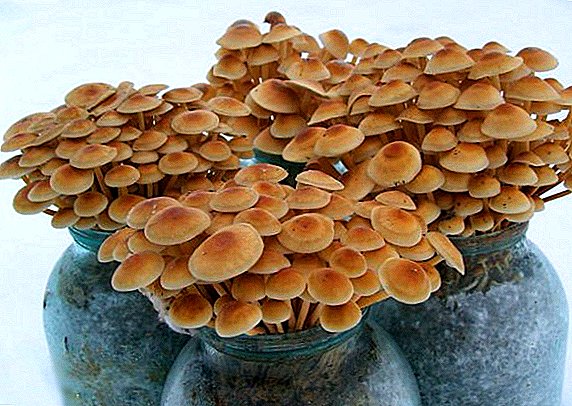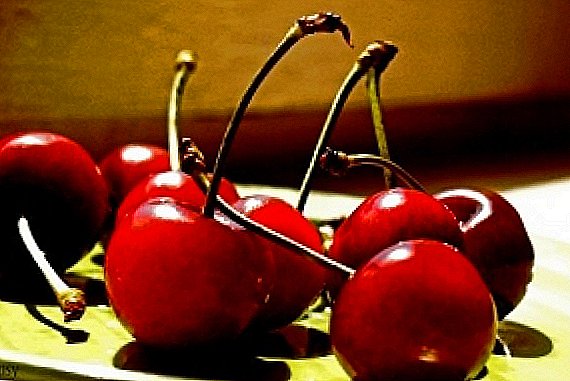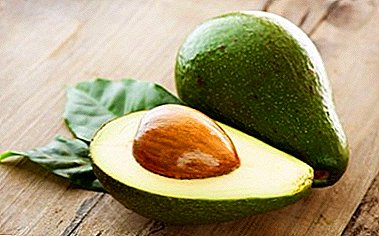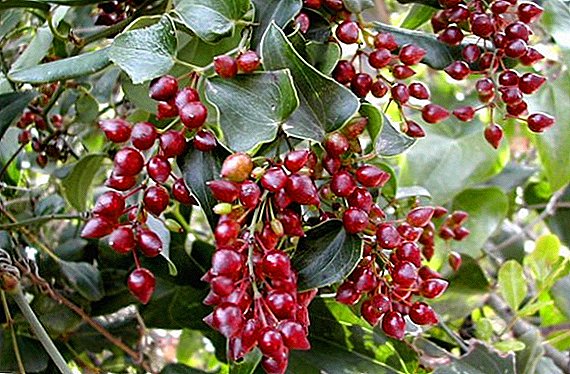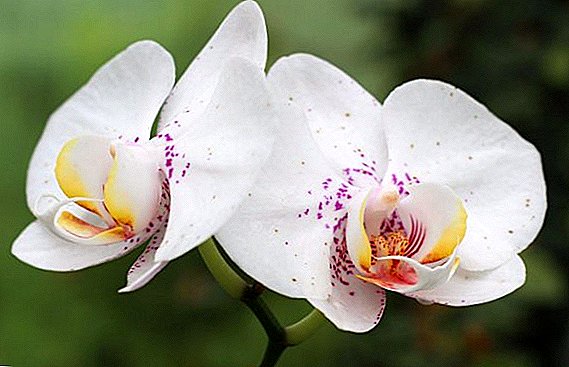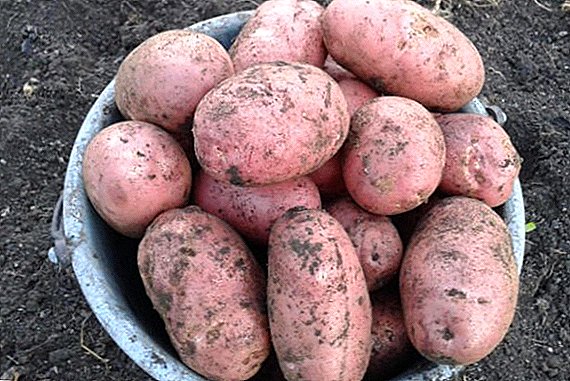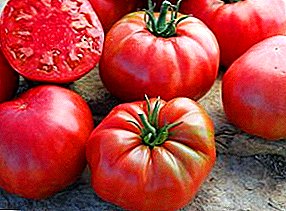 Tomato "Sugar Bison" differs markedly from other varieties of its "relatives", and it received especially good reviews from many gardeners. And today you will learn the description and application of the variety, as well as the agrotechnology of growing vegetables in greenhouses.
Tomato "Sugar Bison" differs markedly from other varieties of its "relatives", and it received especially good reviews from many gardeners. And today you will learn the description and application of the variety, as well as the agrotechnology of growing vegetables in greenhouses.
The history of the removal of tomatoes "Sugar Bison"
Tomato varieties "Sugar Bison" brought out domestic gardeners in Russia through breeding. State registration - 2004. In a matter of months, the vegetable has become popular among greenhouse owners.
Tomato "Sugar Bison": characteristic
Tomato "Sugar Bison" has the following feature:
- Stamba view of the plant.
- You can grow in open ground, but it is better to plant in the greenhouse.
For more information, see the following sections.
Did you know? To remove the smell of a skunk, take a bath from tomato juice.

Description of the bush
The bush grows quite high (up to two meters), the fruits are well illuminated by the sun. The first inflorescence begins to form above the seventh leaf. The following are formed through two sheets.
Description of the fetus
Tomatoes "Sugar Bison" rather large and in shape remind heart. Fruit color - raspberry-pink or red.
Ripe tomatoes reach 350 grams, but most often weigh up to 250 g. However, there are champions: ripe tomatoes can reach 950 g. There are seven chambers in a tomato. Vegetable contains up to 6% of dry matter.

Yield
Tomato "Sugar Bison" has a high yield. The first fruits of the presentation appear on the bushes about three months after germination. From one bush can be collected up to 25 kg of fruits with proper care. And this is only for the season!
Application
Vegetable is used to make juices, salads, pasta. It is also used fresh. It tolerates freezing and is suitable for whole marinating and canning.
The advantages and disadvantages of the variety
After we have discussed the use of the Sugar Bison tomato and the description of the variety, let's talk about its advantages and disadvantages. Advantages:
- High yield.
- Large fruit presentation.
- Excellent taste (matchless without salt and has a sweet aftertaste).
- Intensive growth of tomatoes under the right growing conditions.
- Resistance to diseases.
- It tolerates drought.
- Transportable.
- Good germination of seedlings.
But there are limitations:
- Demanding lighting and watering.
- Grown in greenhouses.
- Affected by brown rot.
For cultivation in the greenhouse suitable such varieties: "Budenovka", "Black Prince", "Honey drop", "Marina Grove", "Mikado Pink".
Sowing seeds for seedlings
It is better to sow the seeds of this variety in late March or early April. If you are going to grow a large number of bushes, you can sow them in large boxes, and if you have a couple of bushes, then there will be enough peat tablets.

To create such an earthen mixture, you will need to combine peat, garden soil, humus and wood ash (2: 1: 1: 1). You can add a small amount of potash and superphosphate.
The finished earth mixture must be sifted and steamed in a double boiler. This will help you get rid of bacteria, weed seeds and fungal spores. The soil turns out friable, moisture-absorbing and breathable.
Planted seedlings should be placed in the afternoon on the window on the south side, and at night just leave on the windowsill. The temperature during the day should be 22 ° C, and at night - 18 ° C.
From the moment of sowing you can water the seedlings once or twice. Additional feeding is not needed. In the peat tablets of eight sifted, only three can break through.
Peculiarities of growing tomatoes "Sugar Bison" in greenhouses
Previously, the tomato "Sugar Bison" preferred to grow in greenhouses, where cucumbers grew. However, this led to such a disease as anthracnose. After that, many gardeners change the soil before planting tomatoes and spray the soil with a solution copper sulphate.
Seven days before planting seedlings you need to prepare the beds. They should be 30 cm high and 90 cm wide. You also need to prepare good drainage and plow the earth.
Planting plantation seedlings
There are two types of seedling planting schemes - single-line and two-line. The single-line landing pattern is 60 × 50 cm, the two-line one is 60 × 40, and between the landing lines you should leave 75-95 cm of free space.

Before planting seedlings, pour the wells with an unsaturated solution of potassium permanganate. You can also add complex organo-mineral supplements.
Important! Transplantation of seedlings is carried out when the stems reach up to 35 cm in height.
Watering and weeding
In the first 14 days of bushes can not be watered. After that, the vegetable should be regularly watered with warm water. Weeding will allow the roots to breathe better and let the moisture through. This procedure can be performed using a Fokin flat cutter.
The first loosening should take place immediately after the planting of seedlings in the greenhouse. Subsequent procedures are performed every two weeks. Loosen better to a depth of 5 cm. Periodically remove weeds, as they affect the growth and yield of tomatoes.
Top dressing of tomatoes
The first and second feeding of tomatoes in greenhouses are held a couple of weeks after the transplant seedlings. To do this, you will need an aqueous solution of mullein with the addition of 50 g of ash.
Important! Do not overfeed tomatoes with ammonium nitrate or mullein before setting fruit. An excess of nitrogen leads to the formation of a strong stalk with abundant foliage, while the yield decreases and there will be no flowering.
The first mineral dressing is carried out 20 days after transplanting. Used for this 1 tbsp. l nitrophosca on 10 liters of water. The second feeding is carried out 10 days after the first. Used for this 1 tsp. potassium sulfate per 10 liters of water.
Two weeks after the second feeding, the following solution of wood ash and superphosphate should be added (2: 1: 10). To speed fruit ripening during fruiting, fertilize the tomatoes with a mixture of nitrophoska, sodium humate and water (1: 1: 10).
Cultivated tomatoes in greenhouses need mineral fertilizers with the addition of potassium, phosphorus and nitrogen.

Nitrogen dressings are applied before picking tomatoes. Potassium fertilizers are made from the moment of formation of the ovaries. To feed such fertilizers tomatoes need up to ripening fruit.
Tomatoes also need magnesium, boron, manganese and zinc. Boron is responsible for the saturation of the fruit with sugars and vitamins, and affects its size and keeping quality.
Magnesium is better to make during the growing season, especially during the formation of ovaries and the development of tomatoes.
Manganese is needed for normal development and growth. It helps to increase the resistance of tomatoes to diseases.
Zinc helps not only in active growth, but also in the formation of large fruits and early ripening.
Bush Formation and Garter
We proceed to the formation of the bush and its garter. Let's start with pasynkovaniya. This is an artificial removal of lateral shoots.
This is done in order to adjust the load on the bush. With a large number of stepsons, the root system does not provide the leaves with sufficient nutrition. Also, a large number of leaves leads to excessive thickening of plantings and poor air circulation between the bushes.
On the main stem leave all formed brushes. The rest of the shoots and inflorescences are removed weekly. To continue the growth of the main stem does not need to remove the escape in the leaf bosom.
It is also interesting to read about the best varieties, especially the cultivation of cherry tomatoes in the greenhouse and the open field.
You need to pinch the top of the shoot after the flowers open on the upper inflorescence. Above them, leave two sheets, as they will supply the vegetables with nutrients.
The next stage is tying. Bushes are tied up by an eight to stakes, a trellis or other types of supports. Since the variety is high, it would be better to use a trellis. The distance between the stakes should be no more than 30 cm. They are driven in along the bed. On the stakes, they stretch the wire and tie up the tomatoes with cloth segments.
Prevention and protection against pests and diseases
As mentioned earlier, the "Sugar Bison" tomatoes are resistant to various diseases and pests, but with the wrong care they are exposed to many diseases and parasites.
Diseases of a tomato can be different: late blight, gray rot, Fusarium, Alternaria, cladosporia and anthracnose.
Late blight of tomatoes can be avoided. To do this, plant the vegetable away from the potatoes and deeply dig the soil before picking. Tomatoes can also be treated with a 1% solution of Bordeaux liquid. You can use folk remedies, instead of chemicals. For example, spraying garlic tincture.

Tomatoes can be saved from gray rot as follows. preventive measures:
- Avoid mechanical damage.
- Plant the bushes at the right distance.
- Treat tomatoes with the "Athlete extra" or "Bravo" fungicides.
From fusarium will help deep processing and digging the soil. Be sure to use healthy tomato seedlings.
Prevention of Alternaria is to clean the remnants of bushes and deep digging of the earth. Healthy bushes can be treated with drugs "Kvadris" or "Tomato Saver".
You can protect yourself from cladosporiosis by removing the remains of dead plants. Tomatoes can be saved from anthracnosis with the help of fungicides "Fundazol" or "Idol".

Now discuss pests. The airing of the greenhouse or the biological preparation "Bowerin" will help to get rid of the whitefly.
Spider mite is removed with the help of the drug "Aktofit". Chemical aids and the biological preparation Verticillin will help from plant aphids.
Did you know? Tomatoes do not have cholesterol, they contain fiber and vitamins A and C.
Tomato varieties "Sugar Bison" has many advantages. We recommend planting it in your garden in order to provide yourself with a useful and tasty vegetable.


